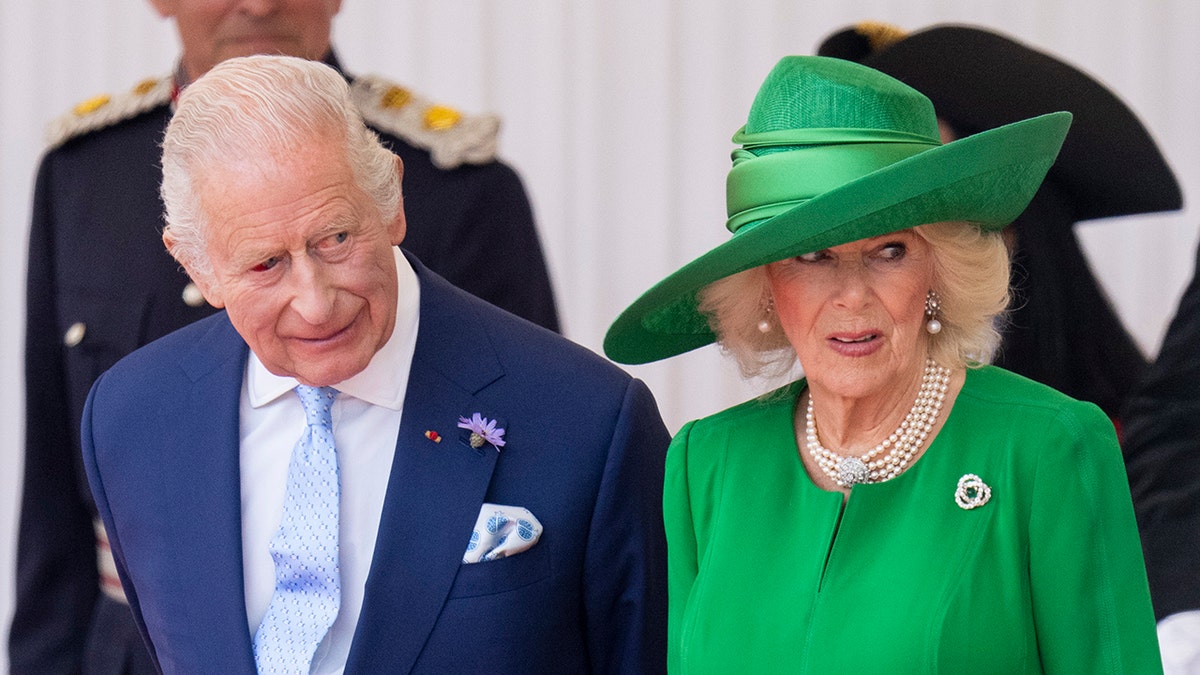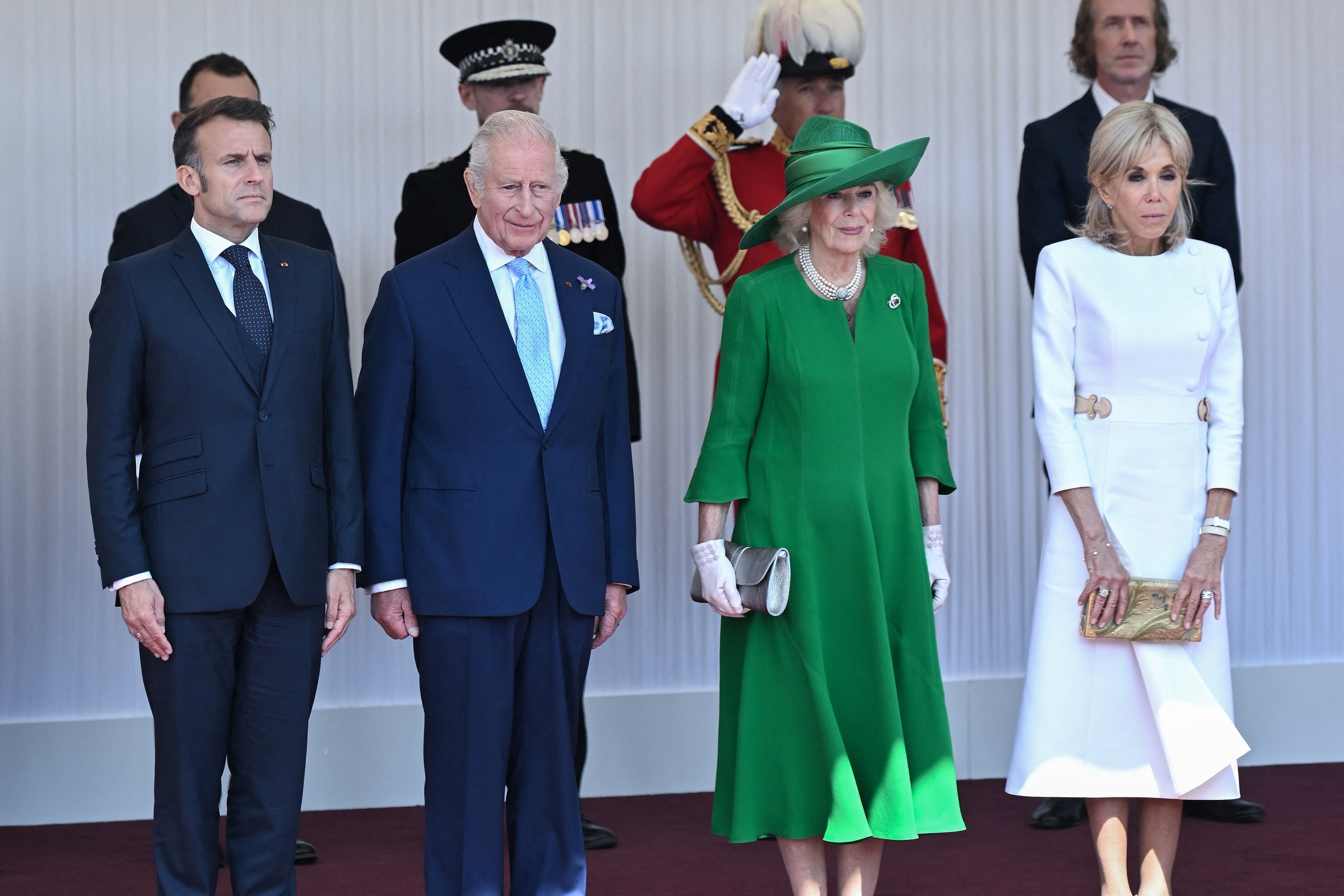On July 8, 2025, King Charles III welcomed French President Emmanuel Macron and his wife, Brigitte, to Windsor Castle for a state visit, a significant diplomatic event celebrating the longstanding ties between Britain and France. However, it was not the ceremonial carriage procession or the glittering state banquet that captured the world’s attention. Instead, it was the King’s visibly bloodshot right eye, which sparked widespread concern and reignited speculation about his health and the future of the British monarchy. With the monarch battling an undisclosed form of cancer since early 2024, the alarming appearance of his eye has prompted questions: Is King Charles’ health deteriorating further, and could he be preparing to abdicate in favor of his son, Prince William? This article explores the incident, the medical explanations, public reactions, and the broader implications for the monarchy.
The Bloodshot Eye Incident: A Cause for Concern?
During the state visit, photographs of King Charles III revealed a strikingly red right eye, a stark contrast to his otherwise composed demeanor. The images quickly went viral, with social media platforms, including X, buzzing with speculation about the monarch’s well-being. Some users suggested the redness could be linked to his ongoing cancer treatment, with one post stating, “Bloodshot eye? Could be from chemo,” though no evidence supports this claim. Others expressed broader concerns, with comments like, “He is NOT well. When he goes, William is going to have to step up big time.”

Buckingham Palace was swift to address the speculation. A palace source clarified to multiple outlets, including People and Fox News, that the redness was due to a subconjunctival hemorrhage—a burst blood vessel in the eye. Medically, this condition is typically benign, akin to a bruise on the skin, and can be triggered by something as simple as a strong cough or sneeze. According to the Mayo Clinic, a subconjunctival hemorrhage is usually harmless, requires no treatment, and resolves within one to two weeks. The Palace emphasized that the condition was unrelated to the King’s cancer treatment, reassuring the public that it was “just one of those things.”
Despite the official explanation, the incident drew attention because it was not the first time King Charles had experienced eye issues. In 2001, he was famously photographed wearing an eye patch after a gardening-related injury, and in 2022, he was spotted with bloodshot eyes in Luton, attributed to possible allergies or dryness. These prior incidents, combined with his ongoing cancer battle, amplified public concern. Health expert Sarah Jeffries, speaking to Tyla, noted that such hemorrhages are common, particularly in older adults, and typically resolve without issue. However, the timing of this latest episode, amid the King’s cancer treatment, fueled speculation about his overall health.
King Charles’ Cancer Diagnosis and Ongoing Treatment
King Charles’ health has been under scrutiny since January 2024, when he was admitted to the London Clinic for treatment of an enlarged prostate. During this hospitalization, doctors identified a separate issue, leading to a cancer diagnosis announced in February 2024. The Palace has not disclosed the specific type of cancer, but the King commenced regular treatments and temporarily paused public-facing duties. By April 2024, he resumed a fuller schedule, with sources describing his recovery as “heading in a very positive direction.” Queen Camilla, during a visit to a cancer center in Bath in September 2024, offered a rare update, stating, “He is doing very well.”

Despite these optimistic updates, the King’s health remains a focal point of public and media attention. A brief hospitalization on March 27, 2025, due to “temporary side effects” from his cancer treatment further intensified concerns. Buckingham Palace described the visit as anticipated and not requiring emergency intervention, but it underscored the ongoing challenges of managing his condition. A royal aide, speaking to The Telegraph, emphasized the King’s resilience, stating, “Medical science has made incredible advances, and I genuinely see no difference in him. As long as you just do what the doctors say, just live your life as normal as possible. That’s exactly what he is doing.”
However, not all reports have been reassuring. Some sources, such as Camilla Tominey in The Telegraph, have suggested that the King’s cancer may be “totally incurable,” with the monarch potentially living “with” the disease rather than overcoming it. Such claims, coupled with the visible bloodshot eye, have kept health concerns at the forefront of public discourse.
Abdication Rumors: A Monarchy in Transition?
The bloodshot eye incident has reignited longstanding rumors about King Charles potentially abdicating the throne. These speculations have been simmering since his cancer diagnosis, with some insiders suggesting that the King and Prince William have held private meetings to discuss the future of the monarchy. A source cited by Now To Love in December 2024 claimed, “Charles will have been told worst and best case scenarios in terms of his health, but it’s clear some of his royal priorities have had to be sidelined.” The source added that the King has been leaning heavily on Prince William, indicating a gradual shift in responsibilities.

Abdication is a sensitive topic in British history, largely due to the constitutional crisis triggered by King Edward VIII’s abdication in 1936 to marry Wallis Simpson. Unlike other monarchies, such as Denmark, where Queen Margrethe II abdicated in 2024 citing health and age, abdication is rare and carries a stigma in the UK. Royal expert Hilary Fordwich, speaking to Fox News, noted that an abdication by King Charles would be a “significant departure from tradition” and could cause a “crisis” for the royal family, particularly for Prince William, who is preparing for his future role as king.
Despite these concerns, King Charles has shown a strong commitment to his duties, following the example of his mother, Queen Elizabeth II, who served until her death in 2022. Experts like Jonathan Sacerdoti have argued that the King is unlikely to abdicate unless absolutely necessary, emphasizing his dedication to duty. The Regency Act of 1937 provides an alternative, allowing the monarch to delegate duties to a Counsellor of State if incapacitated, without formally stepping down. Queen Camilla and Princess Anne have already acted as efficient deputies during periods when Charles and other senior royals were unavailable.
Prince William, the heir apparent, has been increasingly visible, taking on more responsibilities and dismissing abdication rumors with humor. During a visit to Liverpool in January 2025, when a young boy mistakenly called him “the King,” William responded, “No, I’m not, no. I’m his son.” This lighthearted exchange underscored his readiness to assume the throne in due course, but also his support for his father’s continued reign.
Public and Media Reactions
The public’s response to King Charles’ bloodshot eye and health concerns has been mixed. On X, some users expressed alarm, with posts suggesting the King’s condition appeared dire. Others, however, praised his resilience, with one user noting, “Fans on X cheer his grit, but whispers of succession and funeral plans linger.” Mainstream media outlets, including People, Fox News, and HELLO!, have largely echoed the Palace’s reassurances, focusing on the benign nature of the subconjunctival hemorrhage.
Speculation about abdication has also been fueled by historical comparisons and even references to Nostradamus’ prophecies. A Times of India article cited a Nostradamus expert claiming the 16th-century seer predicted a king in his 70s facing resentment and being “driven out by force.” While such interpretations are speculative and lack credibility, they reflect the public’s fascination with the monarchy’s future.
The Future of the Monarchy
King Charles’ bloodshot eye, while medically minor, has served as a potent symbol of his ongoing health challenges and the pressures of his role. At 76, the King is navigating a delicate balance between his duties and his treatment, with the support of Queen Camilla, Prince William, and other royals. The monarchy’s commitment to continuity is evident, with preparations for a potential transition to Prince William underway, though not imminent.
For now, King Charles remains determined to fulfill his responsibilities, as demonstrated by his active participation in the French state visit and plans for a tour to Australia. The Palace’s transparency about his health, a departure from the secrecy of past royals, has humanized the monarchy but also invited scrutiny. Whether the King will abdicate remains uncertain, but his resilience in the face of health challenges underscores his dedication to the crown.
As the world watches, the coming months will be critical in determining the trajectory of King Charles’ reign. The bloodshot eye may fade, but the questions it has raised about his health and the monarchy’s future will linger, shaping discussions about the House of Windsor’s next chapter.

